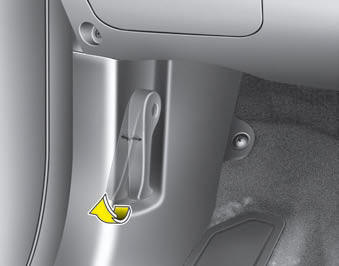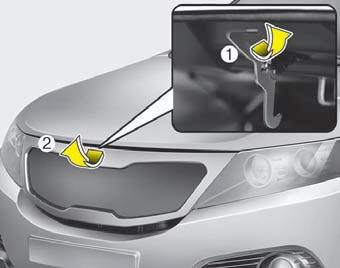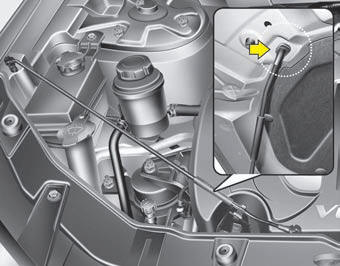Hood

Opening the hood
1. Pull the release lever to unlatch the
hood. The hood should pop open
slightly.

2. Go to the front of the vehicle, raise the hood slightly, pull the secondary latch inside of the hood center and lift the hood.

3.Pull out the support rod from the support rod holder.
4.Place the support rod end in the designated hole on the underside of the hood to hold up the hood.
WARNING - Hot parts
Grasp the support rod in the area
wrapped in rubber. The rubber will
help prevent you from being burned
by hot metal when the engine is
hot.
Closing the hood
1. Before closing the hood, check the following:
• All filler caps in the engine compartment
must be correctly installed.
• Gloves, rags or any other combustible material must be removed from the engine compartment.
2. Return the support rod to its clip to prevent it from rattling.
3. Lower the hood until it is about 30 cm (1 ft.) above the closed position and let it drop. Make sure that it locks into place.
WARNING
• Before closing the hood, ensure
that all obstructions are removed
from the hood opening. Closing
the hood with an obstruction
present in the hood opening may
result in property damage or
severe personal injury.
• Do not leave gloves, rags or any other combustible material in the engine compartment. Doing so may cause a heat-induced fire.
WARNING
• Always double check to be sure
that the hood is firmly latched
before driving away. If it is not
latched, the hood could open
while the vehicle is being driven,
causing total loss of visibility,
which might result in an accident.
• The support rod must be inserted completely into the hole provided whenever you inspect the engine compartment. This will prevent the hood from falling and possibly injuring you.
• Do not move the vehicle with the hood raised. The view will be blocked and the hood could fall or get damaged.
See also:
Body Styles, Trim Levels, and Options
The 2007 Kia Sorento midsize SUV comes in two trim levels: LX and EX. The LX
comes standard with 16-inch wheels, a 10-speaker sound system, full power
accessories, cloth seats and an eight-way adj ...
Special driving conditions
Hazardous driving conditions
When hazardous driving conditions are
encountered such as water, snow, ice,
mud, sand, or similar hazards, follow
these suggestions:
• Drive cautiously and allow ex ...


